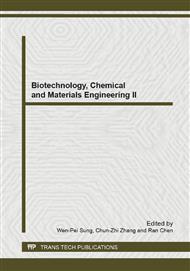[1]
Y. H. Bai, Q. H. Sun, R. H. Sun, Bioaugmentation and adsorption treatment of coking wastewater containing pyridine and quinoline using zeolite-biological aerated filters, Environ. Sci. Technol. 45 (2011) 1940-(1948).
DOI: 10.1021/es103150v
Google Scholar
[2]
N. Yin, G. Yang, Z. X. Zhong, Separation of ammonium salts from coking wastewater with nanofiltration combined with diafiltration, Desalination. 268 (2011) 233-237.
DOI: 10.1016/j.desal.2010.10.034
Google Scholar
[3]
Y. M. Kim, D. Park, D. S. Lee, Inhibitory effects of toxic compounds on nitrification process for cokes wastewater treatment, J. Hazard. Mater. 152 (2008) 915-921.
DOI: 10.1016/j.jhazmat.2007.07.065
Google Scholar
[4]
Y. M. Li, G. W. Gu, J. F. Zhao, Anoxic degradation of nitrogenous heterocyclic compounds by acclimated activated sludge, Process Biochem. 37 (2001) 81-86.
DOI: 10.1016/s0032-9592(01)00176-5
Google Scholar
[5]
Y. M. Li, G. W. Gu, I. Zhao, Treatment of coke-plant wastewater by biofilm systems for removal of organic compounds and nitrogen, Chemosphere. 52 (2003) 997-1005.
DOI: 10.1016/s0045-6535(03)00287-x
Google Scholar
[6]
M. W. Lee, J. M. Park, Biological nitrogen removal from coke plant wastewater with external carbon addition, Water Environ. Res. 70 (1998) 1090-1095.
DOI: 10.2175/106143098x123444
Google Scholar
[7]
G. S. Simate, S. E. Iyuke, S. Ndlovu, The heterogeneous coagulation and flocculation of brewery wastewater using carbon nanotubes, Water Res. 46 (2012) 1185-1197.
DOI: 10.1016/j.watres.2011.12.023
Google Scholar
[8]
Z. P. Xing, D. Z. Sun, Treatment of antibiotic fermentation wastewater by combined polyferric sulfate coagulation, Fenton and sedimentation process, J. Hazard. Mater. 168 (2009) 1264-1268.
DOI: 10.1016/j.jhazmat.2009.03.008
Google Scholar
[9]
K. Lin, D. X. Yuan, M. Chen, Kinetics and products of photo-Fenton degradation of triazophos, J. Agric. Food Chem. 52 (2004) 7614-7620.
DOI: 10.1021/jf048731w
Google Scholar
[10]
X. B. Zhu, J. P. Tian, R. Liu, Optimization of Fenton and electro-Fenton oxidation of biologically treated coking wastewater using response surface methodology, Sep. Purif. Technol. 81 (2011) 444-450.
DOI: 10.1016/j.seppur.2011.08.023
Google Scholar
[11]
Y. Zhang, J. Y. Tian, J. Nan, Effect of PAC addition on immersed ultrafiltration for the treatment of algal-rich water, J. Hazard. Mater. 186 (2011) 1415-1424.
DOI: 10.1016/j.jhazmat.2010.12.015
Google Scholar
[12]
C. Y. Zuo, M. He, P. Y. Zhang, Study on Fenton oxidation cooperated with coagulation of biologically treated coking wastewater, Environ. Sci. 27 (2006) 2201-2205.
Google Scholar
[13]
X. X. Zhang, Y. Ren, C. H. Wei, Adsorption mechanism of organic pollutants from biologically treated coking wastewater by powdered activated carbon, Acta Scientiae Circumstantiae. 27 (2007) 1113-1120.
Google Scholar
[14]
H. S. Li, S. Q. Zhou, Y. B. Sun, Application of response surface methodology to the advanced treatment of biologically stabilized landfill leachate using Fenton's reagent, Waste Manage. 30 (2010) 2122-2129.
DOI: 10.1016/j.wasman.2010.03.036
Google Scholar
[15]
H. L. Zheng, H. Q. Zhang, X. N. Sun, The catalytic oxidation of malachite green by the microwave-Fenton processes, Water Sci. Technol. 62 (2010) 1304-1311.
DOI: 10.2166/wst.2010.411
Google Scholar


